The muscles of the neck Neck The part of a human or animal body connecting the head to the rest of the body. Peritonsillar Abscess can be divided into 3 groups: anterior, lateral, and posterior neck Neck The part of a human or animal body connecting the head to the rest of the body. Peritonsillar Abscess muscles. Each of the groups is subdivided according to function and the precise location of the muscles. The muscles of the neck Neck The part of a human or animal body connecting the head to the rest of the body. Peritonsillar Abscess are mainly responsible for the movements of the head (i.e., extension Extension Examination of the Upper Limbs, flexion Flexion Examination of the Upper Limbs, lateral flexion-extension, and rotation Rotation Motion of an object in which either one or more points on a line are fixed. It is also the motion of a particle about a fixed point. X-rays), but the deep muscles also contribute to more intricate functions (i.e., speaking and swallowing Swallowing The act of taking solids and liquids into the gastrointestinal tract through the mouth and throat. Gastrointestinal Motility).
Last updated: Dec 15, 2025
Superficial layer:
Scalenes: lateral and anterior flexion Flexion Examination of the Upper Limbs of the neck Neck The part of a human or animal body connecting the head to the rest of the body. Peritonsillar Abscess:
Suprahyoids: elevate the hyoid bone Bone Bone is a compact type of hardened connective tissue composed of bone cells, membranes, an extracellular mineralized matrix, and central bone marrow. The 2 primary types of bone are compact and spongy. Bones: Structure and Types during swallowing Swallowing The act of taking solids and liquids into the gastrointestinal tract through the mouth and throat. Gastrointestinal Motility:
Infrahyoids: depress the hyoid bone Bone Bone is a compact type of hardened connective tissue composed of bone cells, membranes, an extracellular mineralized matrix, and central bone marrow. The 2 primary types of bone are compact and spongy. Bones: Structure and Types and facilitate downward movement of the larynx Larynx The larynx, also commonly called the voice box, is a cylindrical space located in the neck at the level of the C3-C6 vertebrae. The major structures forming the framework of the larynx are the thyroid cartilage, cricoid cartilage, and epiglottis. The larynx serves to produce sound (phonation), conducts air to the trachea, and prevents large molecules from reaching the lungs. Larynx: Anatomy after swallowing Swallowing The act of taking solids and liquids into the gastrointestinal tract through the mouth and throat. Gastrointestinal Motility:
The function includes anterior and lateral flexion Flexion Examination of the Upper Limbs of the neck Neck The part of a human or animal body connecting the head to the rest of the body. Peritonsillar Abscess and stabilization of the cervical vertebral column Vertebral column The human spine, or vertebral column, is the most important anatomical and functional axis of the human body. It consists of 7 cervical vertebrae, 12 thoracic vertebrae, and 5 lumbar vertebrae and is limited cranially by the skull and caudally by the sacrum. Vertebral Column: Anatomy:
Splenius group: bilateral contraction ( extension Extension Examination of the Upper Limbs of the neck Neck The part of a human or animal body connecting the head to the rest of the body. Peritonsillar Abscess) and unilateral contraction (lateral flexion Flexion Examination of the Upper Limbs and ipsilateral rotation Rotation Motion of an object in which either one or more points on a line are fixed. It is also the motion of a particle about a fixed point. X-rays):
Suboccipitals (postural muscles): aid in extension Extension Examination of the Upper Limbs, lateral flexion Flexion Examination of the Upper Limbs, and rotation Rotation Motion of an object in which either one or more points on a line are fixed. It is also the motion of a particle about a fixed point. X-rays of the neck Neck The part of a human or animal body connecting the head to the rest of the body. Peritonsillar Abscess:
Transversospinalis group: rotation Rotation Motion of an object in which either one or more points on a line are fixed. It is also the motion of a particle about a fixed point. X-rays and extension Extension Examination of the Upper Limbs of the vertebral column Vertebral column The human spine, or vertebral column, is the most important anatomical and functional axis of the human body. It consists of 7 cervical vertebrae, 12 thoracic vertebrae, and 5 lumbar vertebrae and is limited cranially by the skull and caudally by the sacrum. Vertebral Column: Anatomy:
| Muscle | Origin | Insertion | Blood supply | Innervation | Function |
|---|---|---|---|---|---|
| Platysma | Skin Skin The skin, also referred to as the integumentary system, is the largest organ of the body. The skin is primarily composed of the epidermis (outer layer) and dermis (deep layer). The epidermis is primarily composed of keratinocytes that undergo rapid turnover, while the dermis contains dense layers of connective tissue. Skin: Structure and Functions/ fascia Fascia Layers of connective tissue of variable thickness. The superficial fascia is found immediately below the skin; the deep fascia invests muscles, nerves, and other organs. Cellulitis of the supraclavicular and infraclavicular regions | Base of the mandible Mandible The largest and strongest bone of the face constituting the lower jaw. It supports the lower teeth. Jaw and Temporomandibular Joint: Anatomy, the skin Skin The skin, also referred to as the integumentary system, is the largest organ of the body. The skin is primarily composed of the epidermis (outer layer) and dermis (deep layer). The epidermis is primarily composed of keratinocytes that undergo rapid turnover, while the dermis contains dense layers of connective tissue. Skin: Structure and Functions of the cheek/lower lip, the angle of the mouth, and the orbicularis oris Orbicularis oris Facial Muscles: Anatomy | Branches of the submental and suprascapular arteries Arteries Arteries are tubular collections of cells that transport oxygenated blood and nutrients from the heart to the tissues of the body. The blood passes through the arteries in order of decreasing luminal diameter, starting in the largest artery (the aorta) and ending in the small arterioles. Arteries are classified into 3 types: large elastic arteries, medium muscular arteries, and small arteries and arterioles. Arteries: Histology | Cervical branch of the facial nerve Facial nerve The 7th cranial nerve. The facial nerve has two parts, the larger motor root which may be called the facial nerve proper, and the smaller intermediate or sensory root. Together they provide efferent innervation to the muscles of facial expression and to the lacrimal and salivary glands, and convey afferent information for taste from the anterior two-thirds of the tongue and for touch from the external ear. The 12 Cranial Nerves: Overview and Functions |
|
| SCM | Manubrium Manubrium The upper or most anterior segment of the sternum which articulates with the clavicle and first two pairs of ribs. Chest Wall: Anatomy and medial portion of the clavicle Clavicle A bone on the ventral side of the shoulder girdle, which in humans is commonly called the collar bone. Clavicle Fracture | Mastoid process of the temporal bone Temporal bone Either of a pair of compound bones forming the lateral (left and right) surfaces and base of the skull which contains the organs of hearing. It is a large bone formed by the fusion of parts: the squamous (the flattened anterior-superior part), the tympanic (the curved anterior-inferior part), the mastoid (the irregular posterior portion), and the petrous (the part at the base of the skull). Jaw and Temporomandibular Joint: Anatomy and superior nuchal line | Occipital Occipital Part of the back and base of the cranium that encloses the foramen magnum. Skull: Anatomy and superior thyroid Thyroid The thyroid gland is one of the largest endocrine glands in the human body. The thyroid gland is a highly vascular, brownish-red gland located in the visceral compartment of the anterior region of the neck. Thyroid Gland: Anatomy arteries Arteries Arteries are tubular collections of cells that transport oxygenated blood and nutrients from the heart to the tissues of the body. The blood passes through the arteries in order of decreasing luminal diameter, starting in the largest artery (the aorta) and ending in the small arterioles. Arteries are classified into 3 types: large elastic arteries, medium muscular arteries, and small arteries and arterioles. Arteries: Histology |
|
|
| Subclavius | 1st rib and cartilage Cartilage Cartilage is a type of connective tissue derived from embryonic mesenchyme that is responsible for structural support, resilience, and the smoothness of physical actions. Perichondrium (connective tissue membrane surrounding cartilage) compensates for the absence of vasculature in cartilage by providing nutrition and support. Cartilage: Histology | Subclavian groove of the clavicle Clavicle A bone on the ventral side of the shoulder girdle, which in humans is commonly called the collar bone. Clavicle Fracture | Clavicular branch of the thoracoacromial trunk | Subclavian nerve (from the upper trunk of the brachial plexus Brachial Plexus The large network of nerve fibers which distributes the innervation of the upper extremity. The brachial plexus extends from the neck into the axilla. In humans, the nerves of the plexus usually originate from the lower cervical and the first thoracic spinal cord segments (c5-c8 and T1), but variations are not uncommon. Peripheral Nerve Injuries in the Cervicothoracic Region) |
|
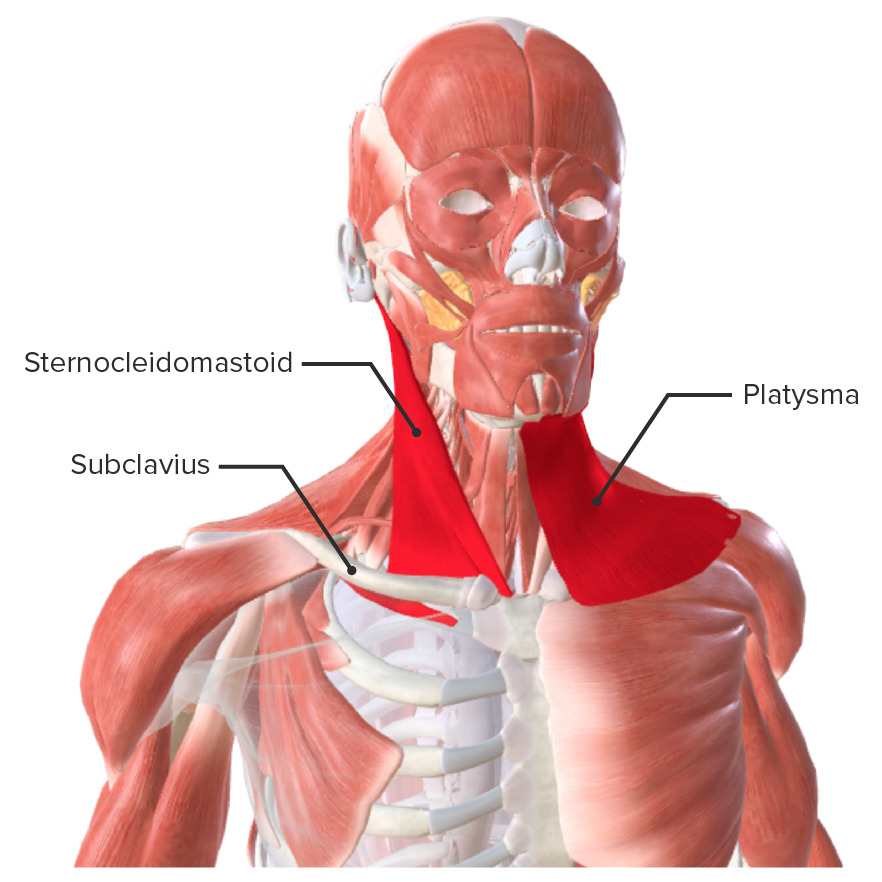
Anterior neck muscles: superficial layer
Image by BioDigital, edited by Lecturio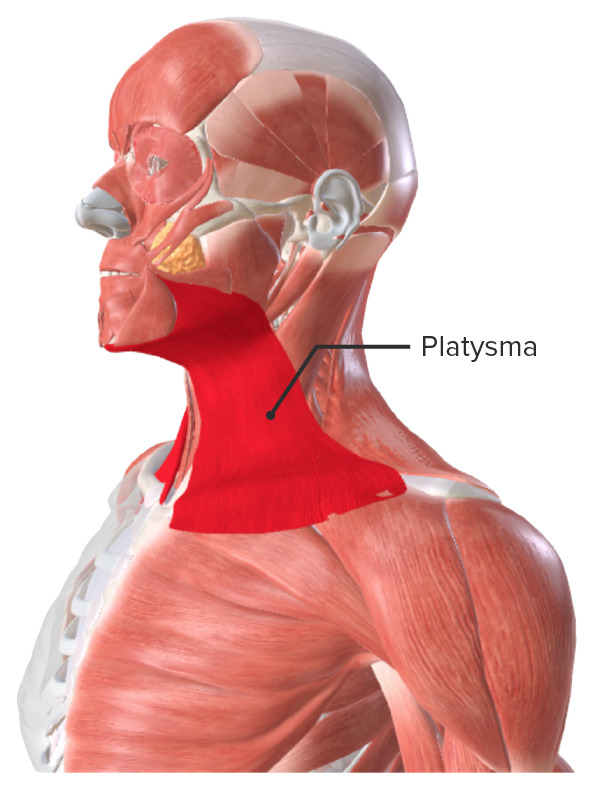
Platysma: lateral view of the head and neck featuring the origin and insertion of the platysma muscle.
Note the platysma is superficial to the sternocleidomastoid muscle.
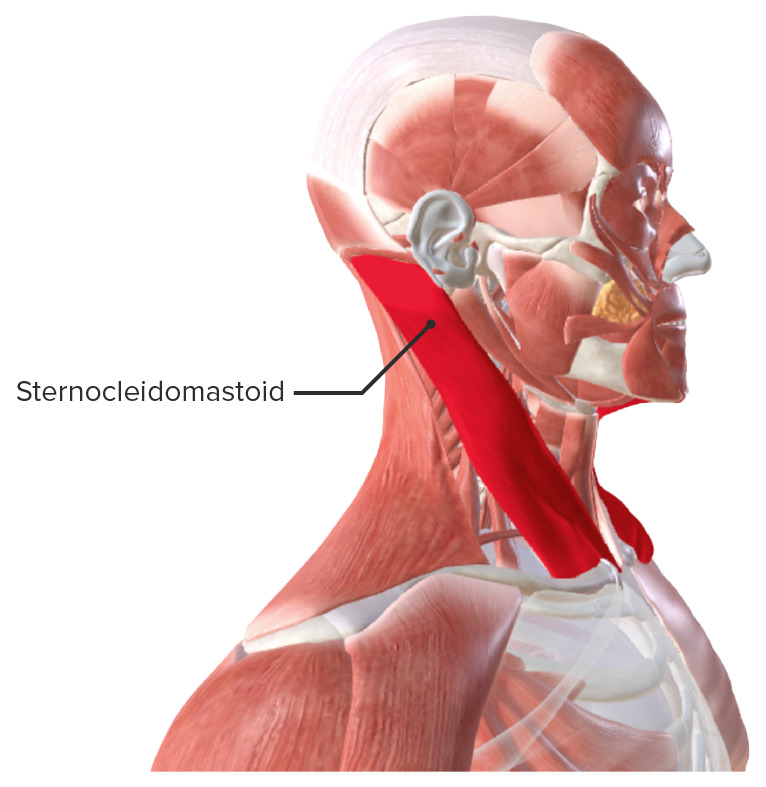
Sternocleidomastoid: lateral view of the neck featuring the origin and insertions of the sternocleidomastoid muscle
Image by BioDigital, edited by Lecturio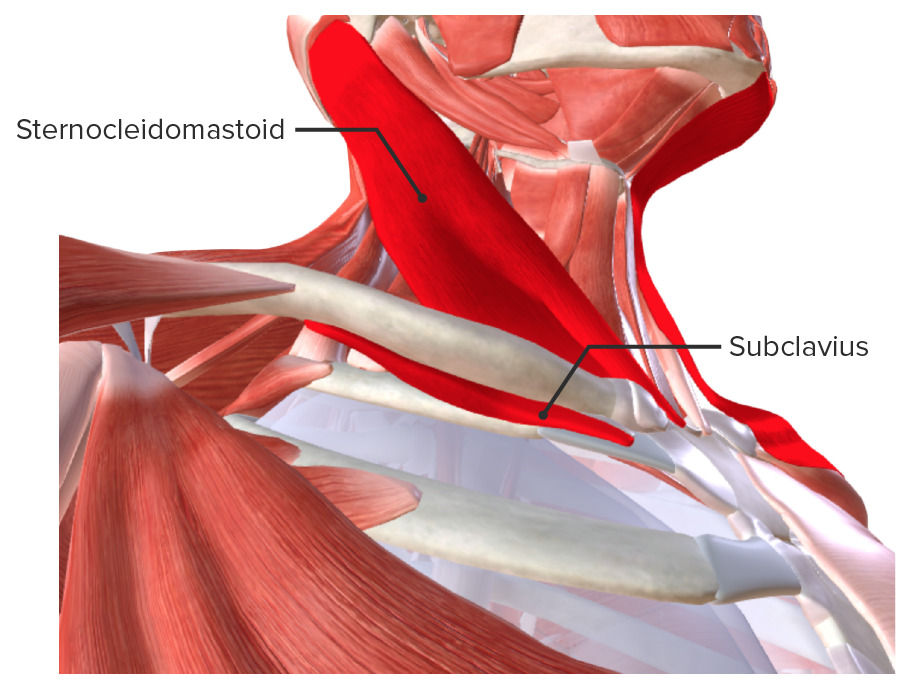
Subclavius and sternocleidomastoid: The superior border of the clavicle serves as the origin of the sternocleidomastoid. The inferior border of the clavicle is the attachment for the subclavius muscle.
Image by BioDigital, edited by Lecturio| Muscle | Origin | Insertion | Blood supply | Innervation | Function |
|---|---|---|---|---|---|
| Anterior scalene | Anterior tubercle of transverse processes of vertebrae C3–C6 | Tubercle on the superior border of the 1st rib | Ascending cervical artery (branch of the inferior thyroid artery Inferior thyroid artery Thyroid Gland: Anatomy) | Anterior rami of spinal nerves Spinal nerves The 31 paired peripheral nerves formed by the union of the dorsal and ventral spinal roots from each spinal cord segment. The spinal nerve plexuses and the spinal roots are also included. Spinal Cord: Anatomy C4–C6 |
|
| Medial (middle) scalene | Posterior tubercles of the transverse processes of vertebrae C3–C7 | Superior border of the 1st rib | Anterior rami of spinal nerves Spinal nerves The 31 paired peripheral nerves formed by the union of the dorsal and ventral spinal roots from each spinal cord segment. The spinal nerve plexuses and the spinal roots are also included. Spinal Cord: Anatomy C3–C8 |
|
|
| Posterior scalene | Posterior tubercles of the transverse processes of vertebrae C5–C7 | External surface of the 2nd rib | Anterior rami of spinal nerves Spinal nerves The 31 paired peripheral nerves formed by the union of the dorsal and ventral spinal roots from each spinal cord segment. The spinal nerve plexuses and the spinal roots are also included. Spinal Cord: Anatomy C6–C8 |
|
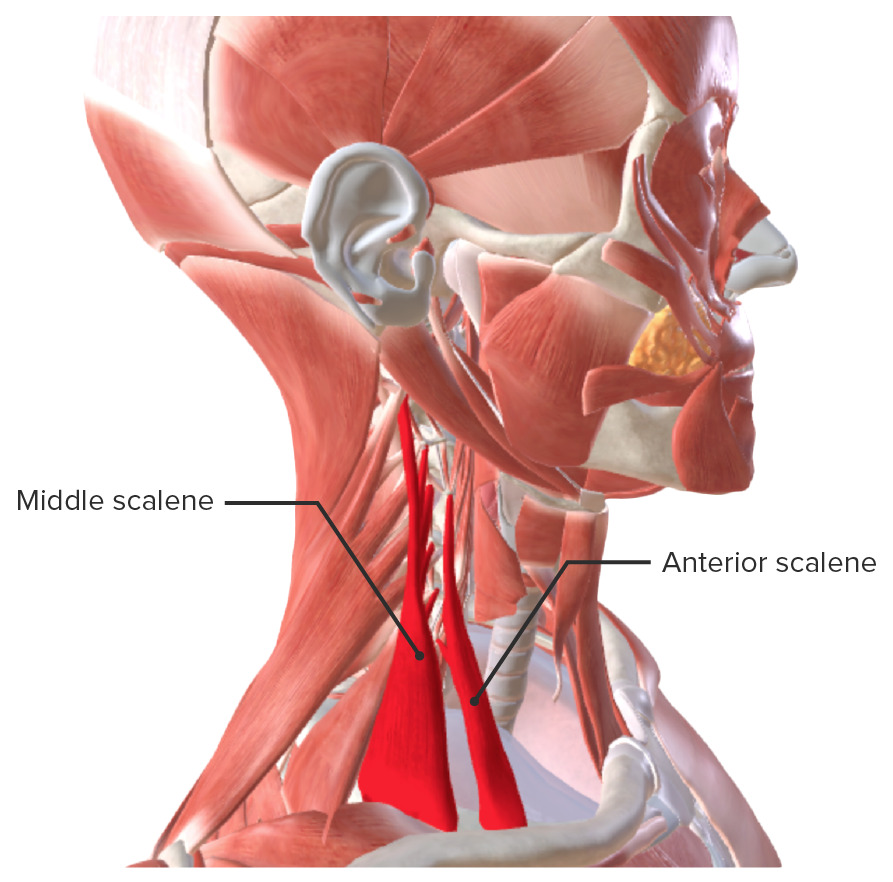
Anterior and middle scalenes
Image by BioDigital, edited by Lecturio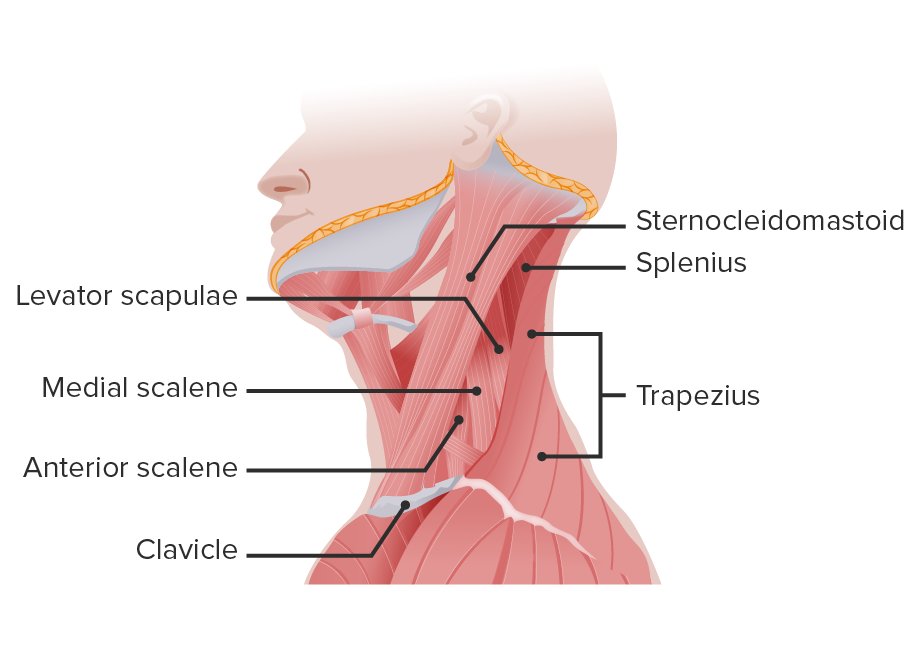
Primary muscles of the neck
Image by Lecturio.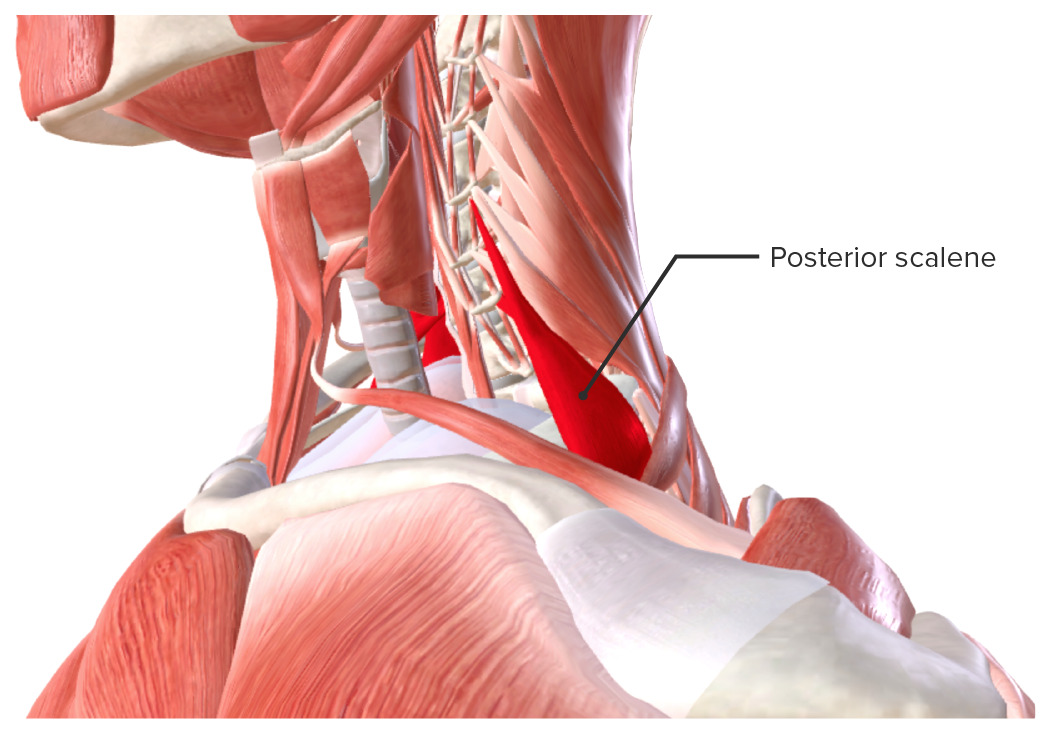
Posterior scalene
Image by BioDigital, edited by Lecturio| Muscle | Origin | Insertion | Blood supply | Innervation | Function |
|---|---|---|---|---|---|
| Digastric |
|
Intermediate tendon on the body of the hyoid bone Bone Bone is a compact type of hardened connective tissue composed of bone cells, membranes, an extracellular mineralized matrix, and central bone marrow. The 2 primary types of bone are compact and spongy. Bones: Structure and Types |
|
|
Opens the jaw Jaw The jaw is made up of the mandible, which comprises the lower jaw, and the maxilla, which comprises the upper jaw. The mandible articulates with the temporal bone via the temporomandibular joint (TMJ). The 4 muscles of mastication produce the movements of the TMJ to ensure the efficient chewing of food. Jaw and Temporomandibular Joint: Anatomy when the masseter Masseter A masticatory muscle whose action is closing the jaws. Jaw and Temporomandibular Joint: Anatomy and temporalis Temporalis A masticatory muscle whose action is closing the jaws; its posterior portion retracts the mandible. Jaw and Temporomandibular Joint: Anatomy are relaxed |
| Mylohyoid | Mylohyoid line of the mandible Mandible The largest and strongest bone of the face constituting the lower jaw. It supports the lower teeth. Jaw and Temporomandibular Joint: Anatomy | Body of the hyoid bone Bone Bone is a compact type of hardened connective tissue composed of bone cells, membranes, an extracellular mineralized matrix, and central bone marrow. The 2 primary types of bone are compact and spongy. Bones: Structure and Types and median ridge | Submental artery and branch of the inferior alveolar artery | Mylohyoid nerve: branch of the mandibular nerve Mandibular nerve A branch of the trigeminal (5th cranial) nerve. The mandibular nerve carries motor fibers to the muscles of mastication and sensory fibers to the teeth and gingivae, the face in the region of the mandible, and parts of the dura. Jaw and Temporomandibular Joint: Anatomy |
|
| Geniohyoid | Inferior mental spine Spine The human spine, or vertebral column, is the most important anatomical and functional axis of the human body. It consists of 7 cervical vertebrae, 12 thoracic vertebrae, and 5 lumbar vertebrae and is limited cranially by the skull and caudally by the sacrum. Vertebral Column: Anatomy of the mandible Mandible The largest and strongest bone of the face constituting the lower jaw. It supports the lower teeth. Jaw and Temporomandibular Joint: Anatomy | Anterior surface of the hyoid bone Bone Bone is a compact type of hardened connective tissue composed of bone cells, membranes, an extracellular mineralized matrix, and central bone marrow. The 2 primary types of bone are compact and spongy. Bones: Structure and Types | Branches of the lingual artery Lingual artery Lips and Tongue: Anatomy | Hypoglossal nerve Hypoglossal nerve The 12th cranial nerve. The hypoglossal nerve originates in the hypoglossal nucleus of the medulla and supplies motor innervation to all of the muscles of the tongue except the palatoglossus (which is supplied by the vagus). This nerve also contains proprioceptive afferents from the tongue muscles. Lips and Tongue: Anatomy (C1) | Raises the hyoid and tongue Tongue The tongue, on the other hand, is a complex muscular structure that permits tasting and facilitates the process of mastication and communication. The blood supply of the tongue originates from the external carotid artery, and the innervation is through cranial nerves. Lips and Tongue: Anatomy during swallowing Swallowing The act of taking solids and liquids into the gastrointestinal tract through the mouth and throat. Gastrointestinal Motility |
| Stylohyoid | Styloid process of the temporal bone Temporal bone Either of a pair of compound bones forming the lateral (left and right) surfaces and base of the skull which contains the organs of hearing. It is a large bone formed by the fusion of parts: the squamous (the flattened anterior-superior part), the tympanic (the curved anterior-inferior part), the mastoid (the irregular posterior portion), and the petrous (the part at the base of the skull). Jaw and Temporomandibular Joint: Anatomy | Greater cornu of the hyoid bone Bone Bone is a compact type of hardened connective tissue composed of bone cells, membranes, an extracellular mineralized matrix, and central bone marrow. The 2 primary types of bone are compact and spongy. Bones: Structure and Types | Branches of the posterior auricular and lingual arteries Arteries Arteries are tubular collections of cells that transport oxygenated blood and nutrients from the heart to the tissues of the body. The blood passes through the arteries in order of decreasing luminal diameter, starting in the largest artery (the aorta) and ending in the small arterioles. Arteries are classified into 3 types: large elastic arteries, medium muscular arteries, and small arteries and arterioles. Arteries: Histology | Facial nerve Facial nerve The 7th cranial nerve. The facial nerve has two parts, the larger motor root which may be called the facial nerve proper, and the smaller intermediate or sensory root. Together they provide efferent innervation to the muscles of facial expression and to the lacrimal and salivary glands, and convey afferent information for taste from the anterior two-thirds of the tongue and for touch from the external ear. The 12 Cranial Nerves: Overview and Functions | Raises the hyoid during swallowing Swallowing The act of taking solids and liquids into the gastrointestinal tract through the mouth and throat. Gastrointestinal Motility |
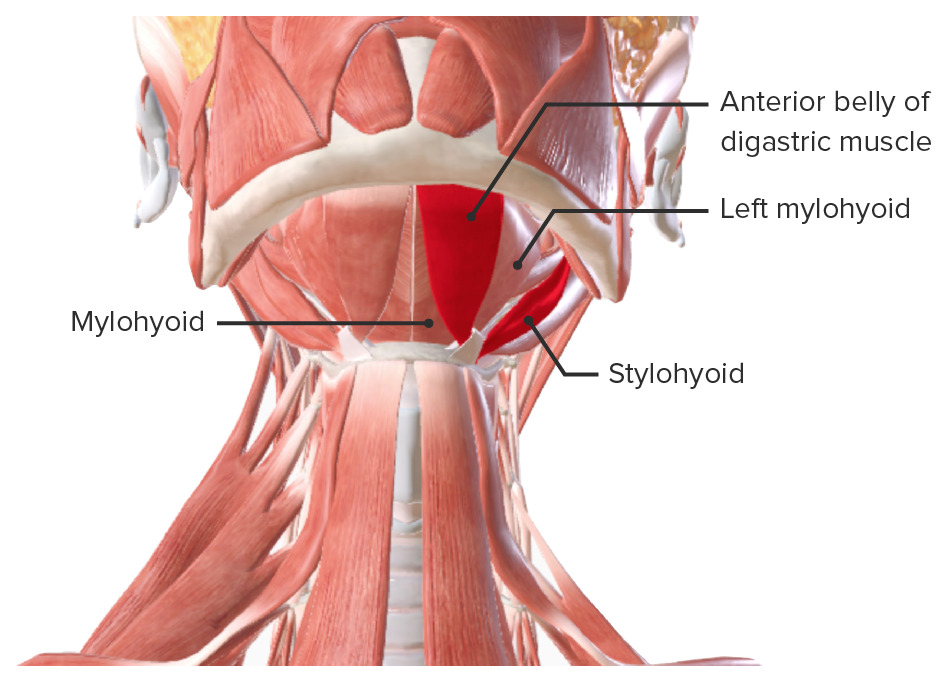
Suprahyoid muscles: digastric, mylohyoid, and stylohyoid.
The muscles are superficial to the geniohyoid muscle.
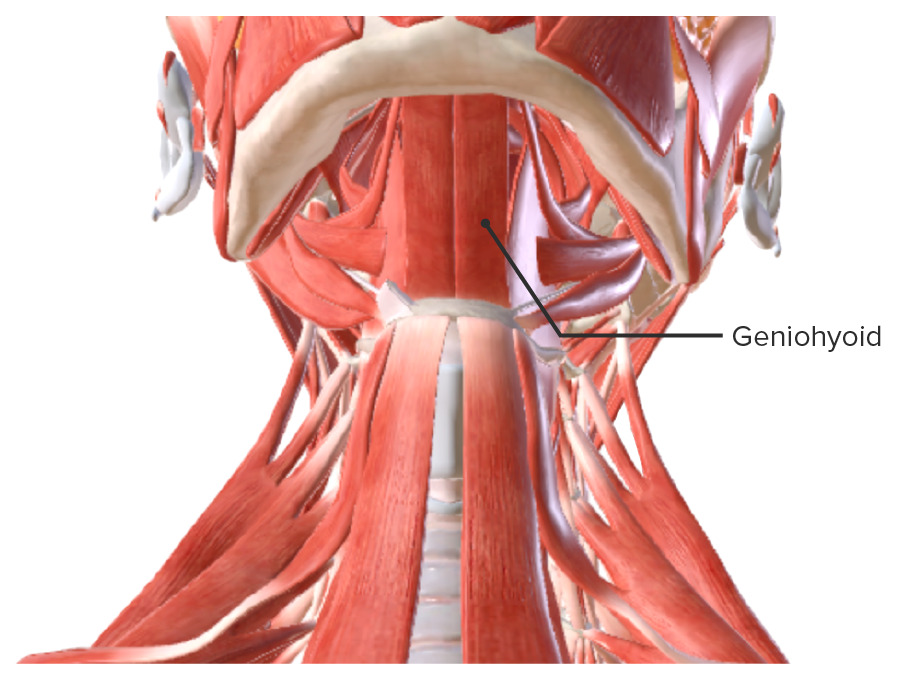
Geniohyoid:
The geniohyoid muscle is deep to the mylohyoid and digastric muscles.
| Muscle | Origin | Insertion | Blood supply | Innervation | Function |
|---|---|---|---|---|---|
| Sternohyoid | Manubrium Manubrium The upper or most anterior segment of the sternum which articulates with the clavicle and first two pairs of ribs. Chest Wall: Anatomy of the sternum Sternum A long, narrow, and flat bone commonly known as breastbone occurring in the midsection of the anterior thoracic segment or chest region, which stabilizes the rib cage and serves as the point of origin for several muscles that move the arms, head, and neck. Chest Wall: Anatomy | Lower border of the body of the hyoid | Superior thyroid artery Superior thyroid artery Thyroid Gland: Anatomy | Branch of ansa cervicalis (C1–C3) | Depresses the hyoid |
| Thyrohyoid | Thyroid Thyroid The thyroid gland is one of the largest endocrine glands in the human body. The thyroid gland is a highly vascular, brownish-red gland located in the visceral compartment of the anterior region of the neck. Thyroid Gland: Anatomy cartilage Cartilage Cartilage is a type of connective tissue derived from embryonic mesenchyme that is responsible for structural support, resilience, and the smoothness of physical actions. Perichondrium (connective tissue membrane surrounding cartilage) compensates for the absence of vasculature in cartilage by providing nutrition and support. Cartilage: Histology | Greater cornu of the hyoid bone Bone Bone is a compact type of hardened connective tissue composed of bone cells, membranes, an extracellular mineralized matrix, and central bone marrow. The 2 primary types of bone are compact and spongy. Bones: Structure and Types | Superior thyroid artery Superior thyroid artery Thyroid Gland: Anatomy | Hypoglossal nerve Hypoglossal nerve The 12th cranial nerve. The hypoglossal nerve originates in the hypoglossal nucleus of the medulla and supplies motor innervation to all of the muscles of the tongue except the palatoglossus (which is supplied by the vagus). This nerve also contains proprioceptive afferents from the tongue muscles. Lips and Tongue: Anatomy (C1) | Elevates the thyroid Thyroid The thyroid gland is one of the largest endocrine glands in the human body. The thyroid gland is a highly vascular, brownish-red gland located in the visceral compartment of the anterior region of the neck. Thyroid Gland: Anatomy and lowers the hyoid |
| Omohyoid |
|
|
Inferior thyroid artery Inferior thyroid artery Thyroid Gland: Anatomy | Ansa cervicalis (C1–C3) |
|
| Sternothyroid | Posterior surface of manubrium Manubrium The upper or most anterior segment of the sternum which articulates with the clavicle and first two pairs of ribs. Chest Wall: Anatomy and 1st rib costal cartilage Cartilage Cartilage is a type of connective tissue derived from embryonic mesenchyme that is responsible for structural support, resilience, and the smoothness of physical actions. Perichondrium (connective tissue membrane surrounding cartilage) compensates for the absence of vasculature in cartilage by providing nutrition and support. Cartilage: Histology | Thyroid Thyroid The thyroid gland is one of the largest endocrine glands in the human body. The thyroid gland is a highly vascular, brownish-red gland located in the visceral compartment of the anterior region of the neck. Thyroid Gland: Anatomy cartilage Cartilage Cartilage is a type of connective tissue derived from embryonic mesenchyme that is responsible for structural support, resilience, and the smoothness of physical actions. Perichondrium (connective tissue membrane surrounding cartilage) compensates for the absence of vasculature in cartilage by providing nutrition and support. Cartilage: Histology |
|
Ansa cervicalis (C1–C3) | Depresses hyoid and larynx Larynx The larynx, also commonly called the voice box, is a cylindrical space located in the neck at the level of the C3-C6 vertebrae. The major structures forming the framework of the larynx are the thyroid cartilage, cricoid cartilage, and epiglottis. The larynx serves to produce sound (phonation), conducts air to the trachea, and prevents large molecules from reaching the lungs. Larynx: Anatomy |
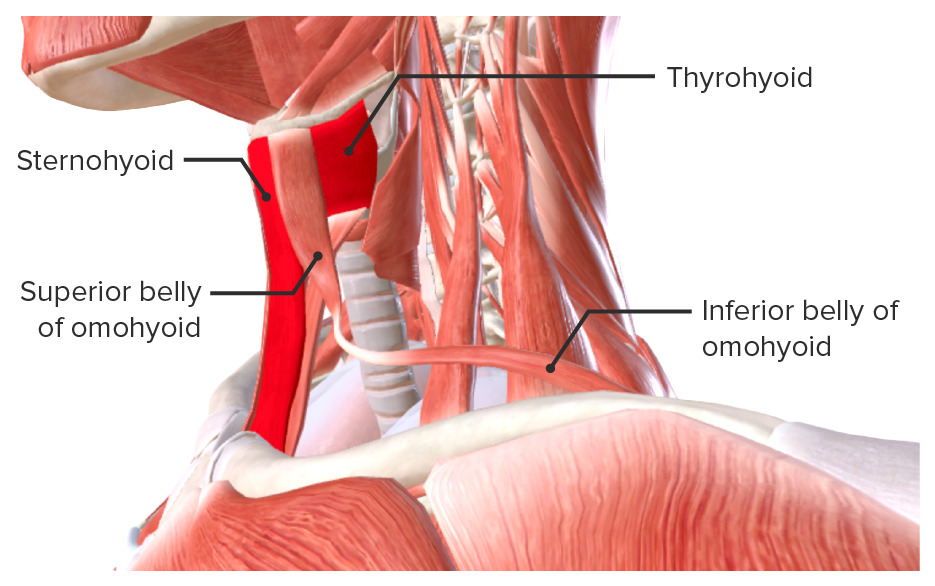
Infrahyoids: thyrohyoid, sternohyoid, and omohyoid
Image by BioDigital, edited by Lecturio| Muscle | Origin | Insertion | Blood supply | Innervation | Function |
|---|---|---|---|---|---|
| Longus capitis | Anterior tubercles of the transverse processes of the 3rd–6th cervical vertebrae Cervical vertebrae The first seven vertebrae of the spinal column, which correspond to the vertebrae of the neck. Vertebral Column: Anatomy | Basilar part of the occipital Occipital Part of the back and base of the cranium that encloses the foramen magnum. Skull: Anatomy bone Bone Bone is a compact type of hardened connective tissue composed of bone cells, membranes, an extracellular mineralized matrix, and central bone marrow. The 2 primary types of bone are compact and spongy. Bones: Structure and Types | Branches of the ascending cervical and inferior thyroid Thyroid The thyroid gland is one of the largest endocrine glands in the human body. The thyroid gland is a highly vascular, brownish-red gland located in the visceral compartment of the anterior region of the neck. Thyroid Gland: Anatomy arteries Arteries Arteries are tubular collections of cells that transport oxygenated blood and nutrients from the heart to the tissues of the body. The blood passes through the arteries in order of decreasing luminal diameter, starting in the largest artery (the aorta) and ending in the small arterioles. Arteries are classified into 3 types: large elastic arteries, medium muscular arteries, and small arteries and arterioles. Arteries: Histology | Nerves C1–C3/C4 | Flexes the neck Neck The part of a human or animal body connecting the head to the rest of the body. Peritonsillar Abscess at the atlantooccipital joint |
| Longus colli | Transverse processes of C5– T3 T3 A T3 thyroid hormone normally synthesized and secreted by the thyroid gland in much smaller quantities than thyroxine (T4). Most T3 is derived from peripheral monodeiodination of T4 at the 5′ position of the outer ring of the iodothyronine nucleus. The hormone finally delivered and used by the tissues is mainly t3. Thyroid Hormones | Anterior arch of the atlas Atlas The first cervical vertebra. Vertebral Column: Anatomy | Ascending pharyngeal and vertebral arteries Arteries Arteries are tubular collections of cells that transport oxygenated blood and nutrients from the heart to the tissues of the body. The blood passes through the arteries in order of decreasing luminal diameter, starting in the largest artery (the aorta) and ending in the small arterioles. Arteries are classified into 3 types: large elastic arteries, medium muscular arteries, and small arteries and arterioles. Arteries: Histology | Nerves C2–C6 | Flexes the neck Neck The part of a human or animal body connecting the head to the rest of the body. Peritonsillar Abscess and head |
| Rectus capitis anterior | Anterior surface of the lateral mass Mass Three-dimensional lesion that occupies a space within the breast Imaging of the Breast of the atlas Atlas The first cervical vertebra. Vertebral Column: Anatomy | Basilar part of the occipital Occipital Part of the back and base of the cranium that encloses the foramen magnum. Skull: Anatomy bone Bone Bone is a compact type of hardened connective tissue composed of bone cells, membranes, an extracellular mineralized matrix, and central bone marrow. The 2 primary types of bone are compact and spongy. Bones: Structure and Types | Ascending pharyngeal artery | Ventral primary rami of spinal nerves Spinal nerves The 31 paired peripheral nerves formed by the union of the dorsal and ventral spinal roots from each spinal cord segment. The spinal nerve plexuses and the spinal roots are also included. Spinal Cord: Anatomy C1–C2 | Flexion Flexion Examination of the Upper Limbs of the neck Neck The part of a human or animal body connecting the head to the rest of the body. Peritonsillar Abscess at the atlantooccipital joint |
| Rectus capitis lateralis | Upper surface of the transverse process of the atlas Atlas The first cervical vertebra. Vertebral Column: Anatomy | Inferior surface of the jugular process of the occipital Occipital Part of the back and base of the cranium that encloses the foramen magnum. Skull: Anatomy bone Bone Bone is a compact type of hardened connective tissue composed of bone cells, membranes, an extracellular mineralized matrix, and central bone marrow. The 2 primary types of bone are compact and spongy. Bones: Structure and Types | Ascending cervical artery | Nerves C1–C2 | Lateral flexion Flexion Examination of the Upper Limbs, stabilizes the atlantooccipital joint |
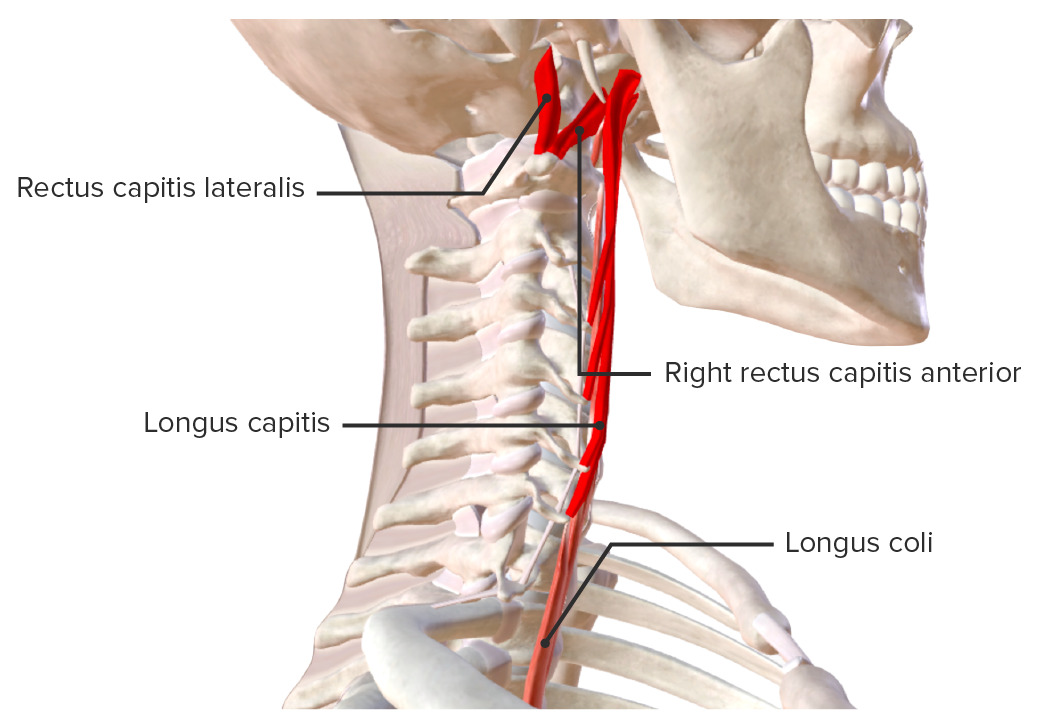
Lateral neck muscles: The rectus capitis lateralis and rectus capitis anterior flex the head and neck and stabilize the atlantooccipital joint.
Image by BioDigital, edited by Lecturio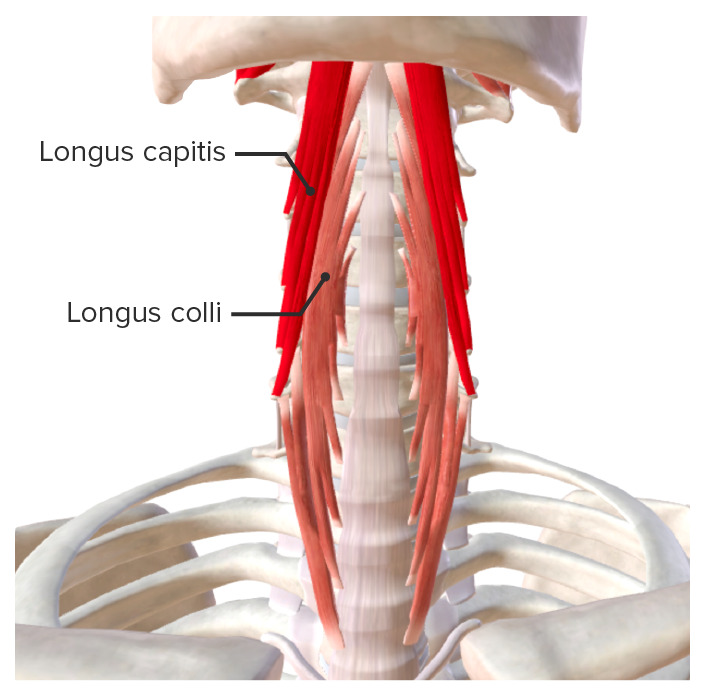
Longus capitis and longus colli
Image by BioDigital, edited by Lecturio| Muscle | Origin | Insertion | Blood supply | Innervation | Function |
|---|---|---|---|---|---|
| Splenius capitis | Nuchal ligament and spinous process of C7– T3 T3 A T3 thyroid hormone normally synthesized and secreted by the thyroid gland in much smaller quantities than thyroxine (T4). Most T3 is derived from peripheral monodeiodination of T4 at the 5′ position of the outer ring of the iodothyronine nucleus. The hormone finally delivered and used by the tissues is mainly t3. Thyroid Hormones | Mastoid process of the temporal and occipital Occipital Part of the back and base of the cranium that encloses the foramen magnum. Skull: Anatomy bones | Branches of the occipital Occipital Part of the back and base of the cranium that encloses the foramen magnum. Skull: Anatomy artery: branch of the external carotid artery External carotid artery Branch of the common carotid artery which supplies the exterior of the head, the face, and the greater part of the neck. Carotid Arterial System: Anatomy | Posterior ramus of spinal nerves Spinal nerves The 31 paired peripheral nerves formed by the union of the dorsal and ventral spinal roots from each spinal cord segment. The spinal nerve plexuses and the spinal roots are also included. Spinal Cord: Anatomy C3–C4 | Extends, rotates, and laterally flexes the head |
| Splenius cervicis | Spinous processes of T3 T3 A T3 thyroid hormone normally synthesized and secreted by the thyroid gland in much smaller quantities than thyroxine (T4). Most T3 is derived from peripheral monodeiodination of T4 at the 5′ position of the outer ring of the iodothyronine nucleus. The hormone finally delivered and used by the tissues is mainly t3. Thyroid Hormones–T6 | Transverse processes of C1–C3 | Transverse cervical and occipital Occipital Part of the back and base of the cranium that encloses the foramen magnum. Skull: Anatomy arteries Arteries Arteries are tubular collections of cells that transport oxygenated blood and nutrients from the heart to the tissues of the body. The blood passes through the arteries in order of decreasing luminal diameter, starting in the largest artery (the aorta) and ending in the small arterioles. Arteries are classified into 3 types: large elastic arteries, medium muscular arteries, and small arteries and arterioles. Arteries: Histology | Posterior rami of the lower cervical spinal nerves Spinal nerves The 31 paired peripheral nerves formed by the union of the dorsal and ventral spinal roots from each spinal cord segment. The spinal nerve plexuses and the spinal roots are also included. Spinal Cord: Anatomy |
|
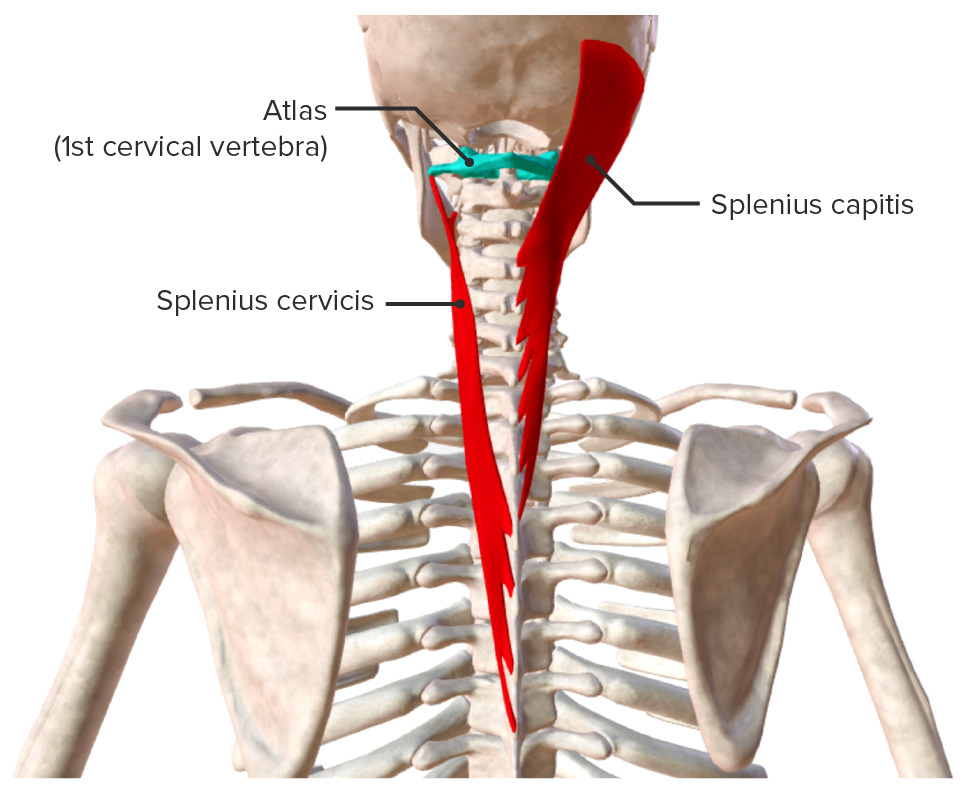
Splenius capitis and splenius cervicis muscles
Image by BioDigital, edited by Lecturio| Muscle | Origin | Insertion | Blood supply | Innervation | Function |
|---|---|---|---|---|---|
| Rectus capitis posterior major | Spinous process of the axis (C2) | Inferior nuchal line of the occipital Occipital Part of the back and base of the cranium that encloses the foramen magnum. Skull: Anatomy bone Bone Bone is a compact type of hardened connective tissue composed of bone cells, membranes, an extracellular mineralized matrix, and central bone marrow. The 2 primary types of bone are compact and spongy. Bones: Structure and Types | Vertebral artery Vertebral artery The first branch of the subclavian artery with distribution to muscles of the neck; vertebrae; spinal cord; cerebellum; and interior of the cerebrum. Lateral Medullary Syndrome (Wallenberg Syndrome), deep descending branch of the occipital Occipital Part of the back and base of the cranium that encloses the foramen magnum. Skull: Anatomy artery | Dorsal ramus of C1, suboccipital nerve | Ipsilateral rotation Rotation Motion of an object in which either one or more points on a line are fixed. It is also the motion of a particle about a fixed point. X-rays and extension Extension Examination of the Upper Limbs of the head |
| Rectus capitis posterior minor | Tubercle on the posterior arch of the atlas Atlas The first cervical vertebra. Vertebral Column: Anatomy (C1) | Medial part of the inferior nuchal line of the occipital Occipital Part of the back and base of the cranium that encloses the foramen magnum. Skull: Anatomy bone Bone Bone is a compact type of hardened connective tissue composed of bone cells, membranes, an extracellular mineralized matrix, and central bone marrow. The 2 primary types of bone are compact and spongy. Bones: Structure and Types | Extends the head at the neck Neck The part of a human or animal body connecting the head to the rest of the body. Peritonsillar Abscess | ||
| Obliquus capitis inferior | Spinous process of the axis | Lateral mass Mass Three-dimensional lesion that occupies a space within the breast Imaging of the Breast of the atlas Atlas The first cervical vertebra. Vertebral Column: Anatomy | Rotation Rotation Motion of an object in which either one or more points on a line are fixed. It is also the motion of a particle about a fixed point. X-rays of the head and neck Neck The part of a human or animal body connecting the head to the rest of the body. Peritonsillar Abscess | ||
| Obliquus capitis superior | Lateral mass Mass Three-dimensional lesion that occupies a space within the breast Imaging of the Breast of the atlas Atlas The first cervical vertebra. Vertebral Column: Anatomy | Lateral half of the inferior nuchal line | Extends and ipsilaterally flexes the head |
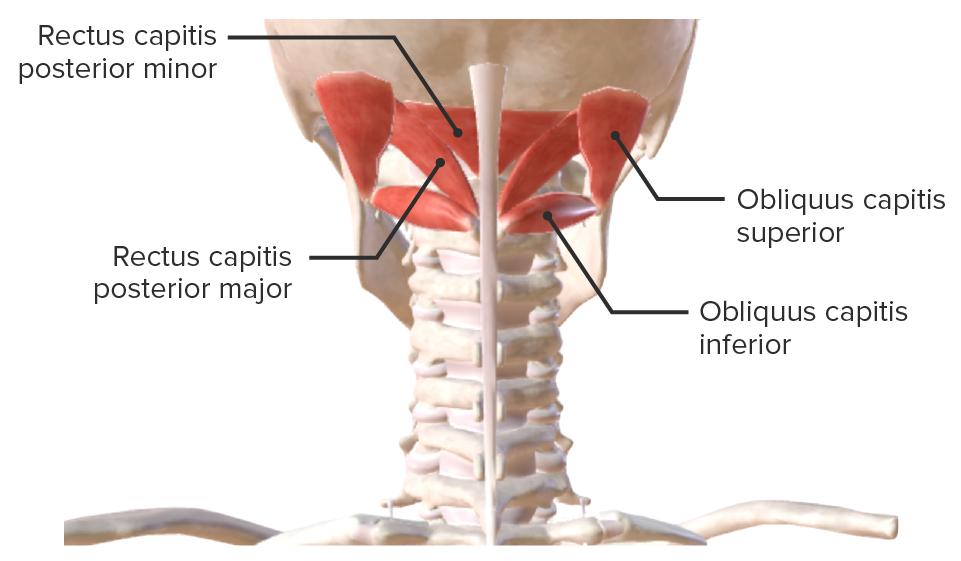
Suboccipital neck muscles
Image by BioDigital, edited by Lecturio| Muscle | Origin | Insertion | Blood supply | Innervation | Function |
|---|---|---|---|---|---|
| Semispinalis capitis |
|
Between the superior and inferior nuchal lines of the occipital Occipital Part of the back and base of the cranium that encloses the foramen magnum. Skull: Anatomy bone Bone Bone is a compact type of hardened connective tissue composed of bone cells, membranes, an extracellular mineralized matrix, and central bone marrow. The 2 primary types of bone are compact and spongy. Bones: Structure and Types | Branches of the occipital Occipital Part of the back and base of the cranium that encloses the foramen magnum. Skull: Anatomy and superior intercostal arteries Arteries Arteries are tubular collections of cells that transport oxygenated blood and nutrients from the heart to the tissues of the body. The blood passes through the arteries in order of decreasing luminal diameter, starting in the largest artery (the aorta) and ending in the small arterioles. Arteries are classified into 3 types: large elastic arteries, medium muscular arteries, and small arteries and arterioles. Arteries: Histology | Branches of the greater occipital Occipital Part of the back and base of the cranium that encloses the foramen magnum. Skull: Anatomy nerve (C2) and spinal nerve (C3) |
|
| Semispinalis cervicis | Transverse processes of T1–T6 | Spinous processes of C2–C5 | Deep cervical artery | Dorsal rami of cervical spinal nerves Spinal nerves The 31 paired peripheral nerves formed by the union of the dorsal and ventral spinal roots from each spinal cord segment. The spinal nerve plexuses and the spinal roots are also included. Spinal Cord: Anatomy |
|
| Rotatores cervicis | Transverse processes |
|
Vertebral and occipital Occipital Part of the back and base of the cranium that encloses the foramen magnum. Skull: Anatomy arteries Arteries Arteries are tubular collections of cells that transport oxygenated blood and nutrients from the heart to the tissues of the body. The blood passes through the arteries in order of decreasing luminal diameter, starting in the largest artery (the aorta) and ending in the small arterioles. Arteries are classified into 3 types: large elastic arteries, medium muscular arteries, and small arteries and arterioles. Arteries: Histology | Postural control | |
| Interspinales cervicis | Side of the apex of the spinous process of C3–T1 | Side of the apex of the spinous process of C2–C7 | Extension Extension Examination of the Upper Limbs of the spine Spine The human spine, or vertebral column, is the most important anatomical and functional axis of the human body. It consists of 7 cervical vertebrae, 12 thoracic vertebrae, and 5 lumbar vertebrae and is limited cranially by the skull and caudally by the sacrum. Vertebral Column: Anatomy | ||
| Intertransversarii | 7 pairs of transverse processes: 1 pair between the atlas Atlas The first cervical vertebra. Vertebral Column: Anatomy and the axis; the remaining pairs between C7 and T1 | Vertebral arteries Arteries Arteries are tubular collections of cells that transport oxygenated blood and nutrients from the heart to the tissues of the body. The blood passes through the arteries in order of decreasing luminal diameter, starting in the largest artery (the aorta) and ending in the small arterioles. Arteries are classified into 3 types: large elastic arteries, medium muscular arteries, and small arteries and arterioles. Arteries: Histology | Anterior rami of the spinal nerves Spinal nerves The 31 paired peripheral nerves formed by the union of the dorsal and ventral spinal roots from each spinal cord segment. The spinal nerve plexuses and the spinal roots are also included. Spinal Cord: Anatomy | Lateral flexion Flexion Examination of the Upper Limbs of the neck Neck The part of a human or animal body connecting the head to the rest of the body. Peritonsillar Abscess | |
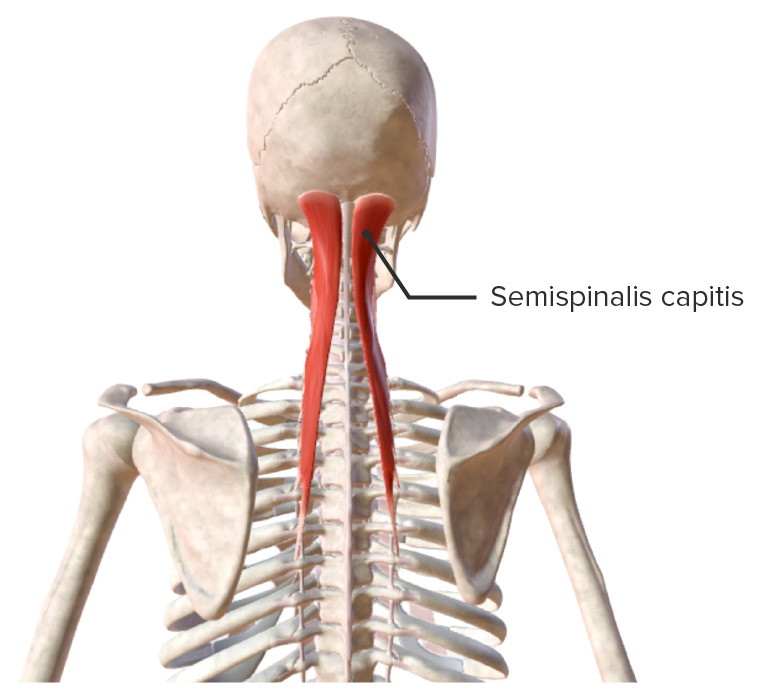
Semispinalis capitis
Image by BioDigital, edited by Lecturio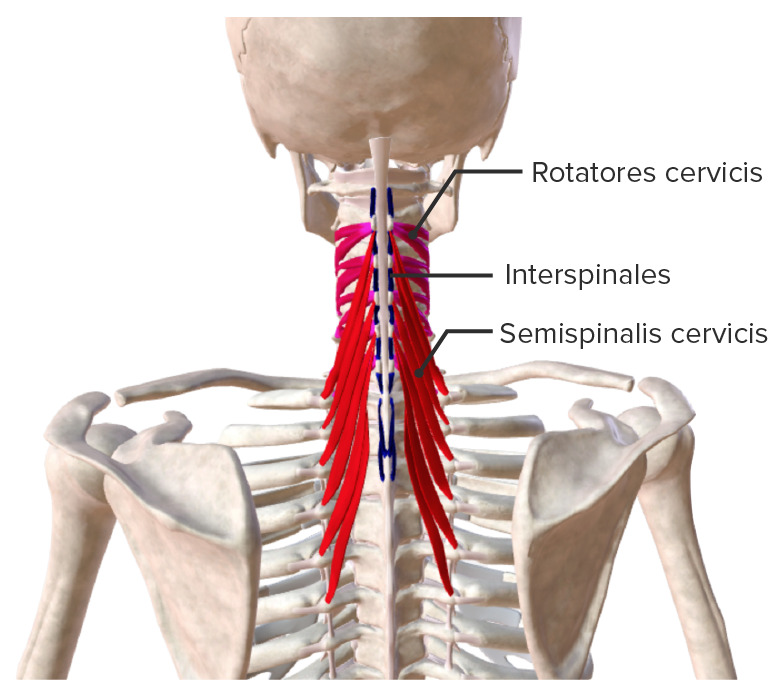
Semispinalis cervicis muscle group:
superficial to the rotatores cervicis and interspinales muscle groups
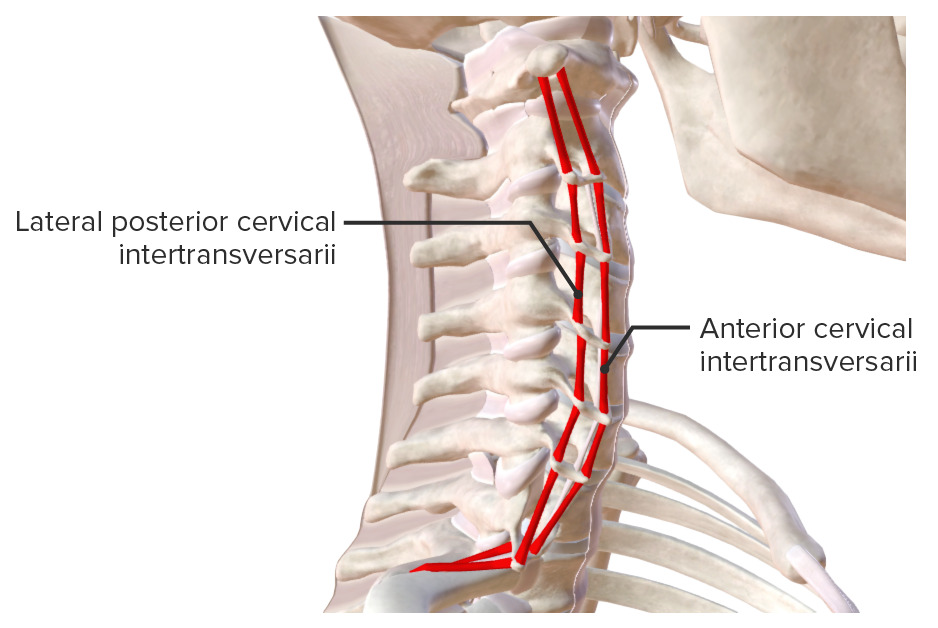
Intertransversarii: The intertransversarii muscles connect the transverse processes of the cervical vertebrae, allowing for lateral flexion of the neck.
Image by BioDigital, edited by Lecturio